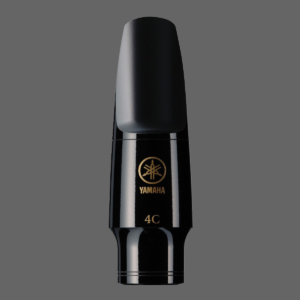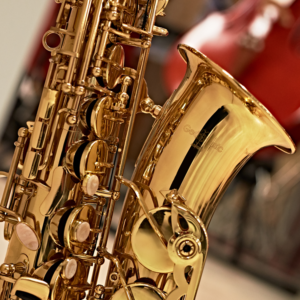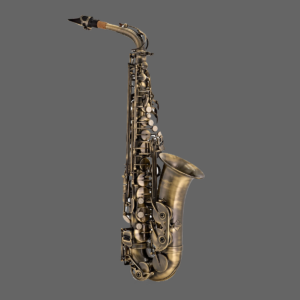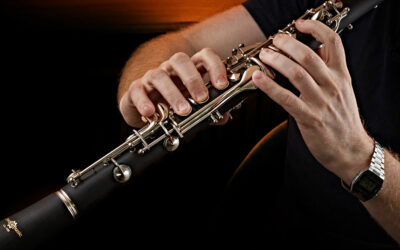So, you’re thinking of learning the saxophone. Picking out a starter instrument can feel daunting, especially with so many models on the market. We’re going to go through some of the basics, so you can figure out exactly what it is you’re looking for.
Which type of saxophone?
The saxophone family is enormous. From the tiniest sopranissimo, to the biggest subcontrabass, there is a saxophone for every octave of the musical scale. But if you’re just starting out, which is the best type of saxophone for you?
It’s generally agreed upon that the best saxophone to learn on is the alto. Larger saxes make it difficult for novices to push through enough air to sound a note, whilst smaller horns require a more developed embouchure (your facial muscles and mouth shape) in order to play in tune.
The alto sits neatly in the middle ground – it’s easy to blow, easy to hold, and has a great, versatile sound. What’s more, all of the skills and techniques you pick up learning the alto sax will be transferrable to the other types. You can always switch later – but learning on alto will give you the best chance of making quick and enjoyable progress.
The tenor is also a viable and commonly picked starter sax, but it requires quite a lot more puff, it’s heavier and harder to hold, and – compared to the alto – is more expensive. If you’re an adult, the first two issues will pose less of a challenge, so many beginners do still set their sights on the tenor saxophone.
We would probably recommend against choosing any other kind of saxophone as a first instrument. Besides the forementioned difficulties with blowing and technique, the other types of saxes tend to be a lot more expensive (for a good quality horn), and beginners’ learning resources will be harder to come across.
With all of that being said, if you have your heart set on a specific saxophone other than the alto, then start with that. It will be a bit harder initially, but if you’re working with a sound that you’re passionate about, then you’ll enjoy yourself more and have better results whilst learning.
This article will focus on the alto saxophone though, as we believe it’s generally the best option for a beginner horn.
Jargon buster
Don’t know your ligature from your bell? Can’t pick between a lacquered or plated finish? We’ll go through some of the basic features which will keep popping up – so you can understand what you’re reading in a product description!
Mouthpieces and reeds
This is where the sound is generated. When blown, the reed vibrates against the mouthpiece, creating a noise which is then shaped by the body of the horn.
Saxophone mouthpieces are detachable, and most professional players will own several, as different pieces are better suited to certain styles and genres. More advanced players might also swap out their ligature, which holds the reed against the mouthpiece.
 When you’re first starting out, you’ll only need one mouthpiece. Beginner horns generally come included with a student-style mouthpiece which will be more than suitable for your first few years of playing. If your sax of choice doesn’t come with one, then buying something like the Yamaha 4C would be a good option.
When you’re first starting out, you’ll only need one mouthpiece. Beginner horns generally come included with a student-style mouthpiece which will be more than suitable for your first few years of playing. If your sax of choice doesn’t come with one, then buying something like the Yamaha 4C would be a good option.
Mouthpieces will almost always come with a ligature, so you needn’t worry about buying one of those separately.
One thing you should consider buying straight away is a box of reeds. Sax reeds are quite delicate, and chipping one is a fairly common occurrence – especially when you’re just starting out! Making sure you have a few reeds in reserve will make your life a lot easier.
Reeds are graded by their thickness – as the number gets higher, the reed gets thicker and harder. Beginners will generally want to start on 2s, and as you develop your technique you can begin to explore harder reeds.
Body materials

Saxophones are most commonly made of brass. However, some higher-end models will be made with different metals. This changes the resonance, and ultimately the tone of the instrument.
Brass delivers the classic saxophone sound. An alloy of copper and zinc, brass comes in a few different forms, which offer different properties – and cost different amounts.
Brass horns offer a versatile platform for tonal development, perfect for all genres and styles.
Yellow Brass has the least copper in its makeup, making it the least expensive form of brass.
Commonly used for student horns, it has less innate warmth than more copper-rich brasses but offers a good blank slate for discovering and developing your own tonal colour.
Gold Brass has a higher copper to zinc ratio, resulting in a more resonant metal.
Horns made from gold brass will have a brighter, richer tone than those made from yellow brass – but they also come with a bigger price tag.
Red Brass has the highest copper content. A sax made with red brass will have lots of natural resonance, and a highly coloured tone. However, this comes at the expense of less tonal flexibility.
Bronze is a denser metal than brass, and horns made from it have more presence and character in their sound. Warmer tones and a head-turning aesthetic come at the expense of a heavier, more cumbersome horn – and of course, quite a lot more money.
Silver is an extremely dense and soft metal; it creates a fantastically resonant sax. Favoured for classical and ensemble work, silver horns produce a darker, refined tone with less piercing, high frequencies. This makes it also popular among softer jazz or big band players. However, due to the softness of the metal, it is more delicate and prone to denting. A solid silver sax will also, unsurprisingly, cost you a pretty penny.
For most beginners, price alone will push them towards a brass-bodied sax. This would probably be our recommendation even if you had a blank cheque though. Learning on a more transparent, uncoloured saxophone will give you a better chance to explore the way your embouchure and technique can colour the sound of your playing.
Bell materials
The bell is the main point of projection for the saxophone’s sound. It’s normally made from the same material as the rest of the sax’s body. However, making the bell with a different metal is a way to colour the overall tone of the horn in a more subtle manner. It’s also much cheaper to have a silver bell, for example, than a whole solid silver saxophone.
The bell material affects the performance of a saxophone in much the same way as body material, albeit to a lesser extent.
As with body material, we would suggest just getting a horn with a brass bell when you’re starting out. Learning on a horn with too much innate tonal colour will make it harder to see the way your playing influences the sound of the saxophone.
Finish
Saxophones are commonly finished with a lacquer to prevent the metal body from tarnishing. The finish of a saxophone is largely an aesthetic choice, although it does affect the overall sound of the horn as well.
Painting a lacquer all over the metal body of a saxophone will change the way it responds. A lacquered body will be less resonant, as the metal’s vibration will be dampened. This means that a sax with lacquer will have a more focused sound with fewer overtones.
An unlacquered instrument will have a more rounded tone, as the overtones are allowed to resonate more freely.
Here are some of the common finishes, and how they’ll affect the saxophone.
Lacquered finishes are the most common for saxophones. Described as either “clear lacquer” or “gold lacquer”, it is a transparent seal which preserves the natural colour of the instrument and prevents tarnishing and corrosion.
Great for both jazz and classical players, the lacquer diffuses some of the natural overtones in the instrument, creating a more tonally focussed sound.
Coloured lacquers have the exact same effect on a saxophone, but to a greater extent. Painting a coloured lacquer on a sax requires a thicker layer in order to attain a consistent result. This means that the metal is even less resonant, and the sound more focussed.
Saxophones can be painted any colour, from black, to pink, to a faux vintage pattern.
Unlacquered instruments are left untreated, causing the metal to quickly tarnish and form a patina on the surface. The patina prevents the horn from corroding, whilst adding to a unique, vintage aesthetic over time.
Allowed to resonate unhindered, the saxophone has a rounder, warmer sound, with the overtones adding colour. Great for jazz, but not so much for classical work.
Silver-plated saxes have had a layer of silver electroplated to the body of the saxophone. Silver is largely inert, which means it forms a great protective barrier between the body of the instrument and the elements. (That isn’t to say a silver-plated horn is immune to tarnishing, and they in fact require quite diligent upkeep to stay looking as new!)
The added weight of the silver reduces the resonance of the horn, giving the sound a mellower, more classical tone.
Many horns come with multiple options for the finish. We think that you need to love both the sound and the look of your instrument, so it’s important to pick something that you’re going to enjoy looking at as well as playing. However, it’s always worth bearing in mind the effect your desired finish will have on the sound of your horn!
Product recommendations
Here are three starter saxes that we think would set you off on the right foot.

Gear4music AS-100
We offer an affordable, reliable, and versatile alto saxophone in the Gear4music AS-100. Available in a variety of finishes, this starter horn is absolutely perfect for beginners looking to work through their first few grades.
With its easy-blowing playability and great intonation, this sax will start giving you good results from the very first session. It comes with everything you’d need at the start of your saxophone journey, with a hard carry case, strap, pad saver, mouthpiece, and reed thrown in.
 Buffet 100 Series
Buffet 100 Series
If you’re looking to invest a bit more money into your first sax, the Buffet 100 Series is a fantastic alto with a darker, more textured sound. Buffet, known for their world-leading clarinets, are no stranger to building quality woodwind instruments. Their 100 Series Altos are made from yellow brass, finished with clear lacquer.
Their design produces a lovely mellow tone, ideal for classical ensembles or a smoky jazz sound. The sax comes with a Buffet gig bag, mouthpiece and reed – so you can get playing immediately.
 Yamaha YAS-280
Yamaha YAS-280
Considered by many to be the definitive student saxophone, the Yamaha YAS-280 was designed from the ground up for students.
It comes recommended by countless tutors, with beginner-friendly features such as a key guard – to protect the mechanical keywork from the inevitable knocks and bumps a sax will suffer at the hands of a new player.
Available with a clear lacquer or silver-plated finish, this easy-blowing horn represents the absolute gold standard of beginner saxophones. It comes in at a higher price-point than many other student horns, but you’re paying for the peace of mind in build quality and consistency which always comes with a Yamaha instrument.
This horn also includes a backpack style case and Yamaha’s excellent 4C mouthpiece.
A point on price
For most people looking to dip their toe into learning a musical instrument, budget is the primary constraint. No one wants to over-invest in a fledgling hobby that they might end up not enjoying. That’s why our three product recommendations are proper student saxophones, at student price points.
What if you have more money at your disposal though? Is it worth skipping the beginner horns and getting a professional model straight away?
Well, as with most things, money buys quality in the saxophone world. This doesn’t mean that the most expensive saxophone is always the best saxophone, but as a general rule, better horns will cost more.
A professional-quality saxophone will play better than a student horn. Learn on a pro sax, and you’ll never be held back by your instrument – you may well progress quicker. You’ll also never outgrow your horn, and so won’t have to swap it out for a more expensive model.
For these reasons, buying the best saxophone you can afford isn’t necessarily a bad strategy.
However, it’s definitely worth keeping in mind that until you have some experience playing the sax, you won’t know what you do and don’t like. For that reason, it can be worth learning the basics on a student horn and figuring out exactly what kind of tone and style you’re looking to explore in the future.
That way, when the time comes to drop the big bucks on a pro sax, you’ll be making an informed decision and buying something which suits the experienced player that you are, rather than guessing what it is that you’ll end up liking.
Find out more
Now that you have a better idea of what you want out of your first saxophone, why not explore our range?
Shop now | Alto Saxophones
Shop now | Saxophones





0 Comments